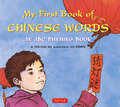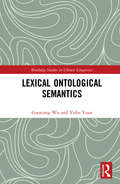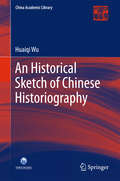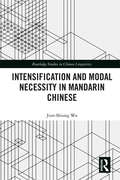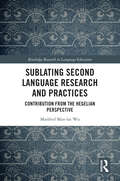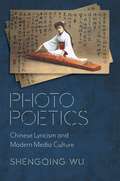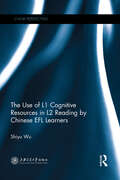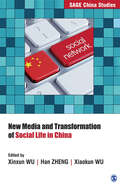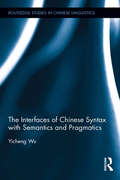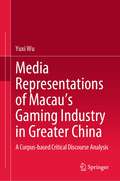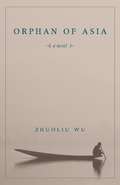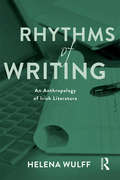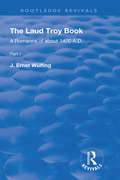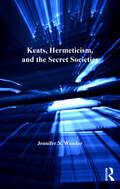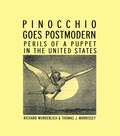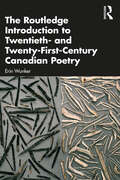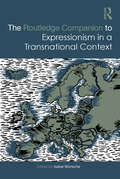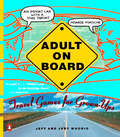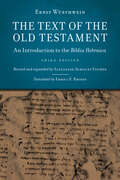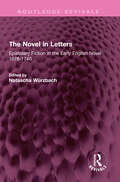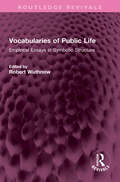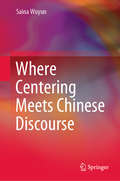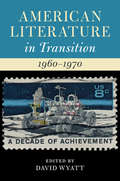- Table View
- List View
My First Book of Chinese Words
by Faye-Lynn Wu Aya PadrónMy First Book of Chinese Words introduces young children to basic words and concepts in the Chinese language through colorful rhymes and beautiful imagery. It is a book that parents and young children will enjoy reading together. The Chinese words in the book are all common, everyday items and the rhymes are informative and fun for children.The goal of My First Book of Chinese Words is to familiarize children with the basic sounds and written characters of Chinese; to introduce core concepts of Chinese culture and to illustrate the ways in which Chinese sounds differ from English ones. Teachers and parents will welcome the cultural notes at the back of the book and appreciate how the book is organized using a familiar ABC structure. Each word is presented in Chinese characters (both Simplified and Traditional) as well as Romanized Pinyin for easy pronunciation.With the help of this book, we hope more children (and adults) will soon join the more than one billion people worldwide who speak Chinese!
My First Book of Chinese Words
by Faye-Lynn Wu Aya Padrón"Z is for zàijiàn. "Goodbye!" we say- more good times together when we meet another day."My First Book of Chinese Words introduces Chinese language to preschool children in a gentle, playful way. The ABC structure provides a familiar framework that encourages fun and easy learning. The everyday words presented in this book include many that have special significance in Chinese culture. Each word is presented in Chinese characters (both Simplified and Traditional) as well as in Romanized form (Pinyin). Cultural and linguistic notes enhance the learning experience. And kids will love the wonderful Chinese family, beautifully illustrated in gentle colors, who will take them from page to page!
Lexical Ontological Semantics (Routledge Studies in Chinese Linguistics)
by Guoxiang Wu Yulin YuanLexical Ontological Semantics introduces ontological methods into lexical semantic studies with the aim of giving impetus to various fields of endeavours which envision and model the semantic network of a language. Lexical ontological semantics (LOS) provides a cognition-based computation-oriented framework in which nouns and predicates are described in terms of their semantic knowledge and models the mechanism in which the noun system is coupled with the predicate system. It expands the scope of lexical semantics, updates methodologies to semantic representation, guides the construction of semantic resources for natural language processing, and develops new theories for human-machine interactions and communications.
An Historical Sketch of Chinese Historiography (China Academic Library)
by Huaiqi WuThis book systematically traces the development of Chinese historiography from the 2nd century B. C. to the 19th century A. D. Refusing to fit the Chinese historical narration into the modern Western discourse, the author highlights the significant questions that concern traditional historians, their philosophical foundations, their development over three thousand years and their influence on the intelligentsia. China is a country defined in terms of its history and its historians have worked hard to record the past. However, this book approaches Chinese history from the very beginning not only as a way of recording, but also as a way of dealing with the past in order to orient the people of the present in the temporal dimension of their lives. This book was listed as the key textbook of the "Eleventh Five-year Plan" for college students in China.
Intensification and Modal Necessity in Mandarin Chinese (Routledge Studies in Chinese Linguistics)
by Jiun-Shiung WuThis book addresses intensification and modal necessity in Mandarin Chinese. Intensification is used in this book to describe the speaker’s emphasis on a proposition, because, by emphasizing on a proposition, the speaker intensifies the degree of his/her confidence and affirmativeness toward the truth of a proposition, cf. the distinction between ‘weaker’ and ‘stronger’. Modal necessity discussed in this book refers either to the speaker’s certainty regarding the truth of an inference, judgment or stipulation, that is, epistemic necessity or to the speaker’s certainty concerning the obligatoriness of a proposition, based on rules or regulations, i.e., deontic necessity. This book examines a series of lexical items in Mandarin Chinese that express either intensification or modal necessity, provides a unified semantics and also presents how these lexical items are semantically distinct. Intensification and Modal Necessity in Mandarin Chinese is aimed at instructors, researchers and post-graduate students of Chinese Linguistics.
Sublating Second Language Research and Practices: Contribution from the Hegelian Perspective (Routledge Research in Language Education)
by Manfred Man-fat WuWu’s book provides an innovative perspective on, and recommendations for, the major aspects of second language (L2) teaching from a Hegelian anthro-philosophical perspective. Language is social in nature and is related to the larger social milieu. Hegelian philosophy of language complements existing research and theories on L2 learning by not only equipping them with a systematic framework but also broadening their scope. In Hegelian philosophy, language not only has its individual and interpersonal dimensions but is also related to the community, society, and morality. The Hegelian perspective also suggests a number of functions of L2 which have either been neglected or rejected by L2 researchers. This book highlights these neglected elements such as intersubjectivity, mutual recognition, universalization and objectivization of inner subjectivity of individuals, as well as moral enhancement. These concepts generate insights on the teaching and learning of L2. Wu’s volume also covers how the Hegelian anthro-philosophical perspective can help to re-interpret research results on L2 learner characteristics that are related to L2 learning to date such as L2 identity and autonomy. The book offers an alternative research paradigm, teaching philosophy, pedagogical implications, and suggestions for scholars, practitioners, and students in the professional field of L2 teaching.
Photo Poetics: Chinese Lyricism and Modern Media Culture (Global Chinese Culture)
by Shengqing WuChinese poetry has a long history of interaction with the visual arts. Classical aesthetic thought held that painting, calligraphy, and poetry were cross-fertilizing and mutually enriching. What happened when the Chinese poetic tradition encountered photography, a transformative technology and presumably realistic medium that reshaped seeing and representing the world?Shengqing Wu explores how the new medium of photography was transformed by Chinese aesthetic culture. She details the complex negotiations between poetry and photography in the late Qing and early Republican eras, examining the ways traditional textual forms collaborated with the new visual culture. Drawing on extensive archival research into illustrated magazines, poetry collections, and vintage photographs, Photo Poetics analyzes a wide range of practices and genres, including self-representation in portrait photography; gifts of inscribed photographs; mass-media circulation of images of beautiful women; and photography of ghosts, immortals, and imagined landscapes. Wu argues that the Chinese lyrical tradition provided rich resources for artistic creativity, self-expression, and embodied experience in the face of an increasingly technological and image-oriented society. An interdisciplinary study spanning literary studies, visual culture, and media history, Photo Poetics is an original account of media culture in early twentieth-century China and the formation of Chinese literary and visual modernities.
The Use of L1 Cognitive Resources in L2 Reading by Chinese EFL Learners (China Perspectives)
by Shiyu WuThis book focuses on the effects of L1 cognitive resources on L2 reading e.g. the effects of L1 reading ability, the ability in L1 mental-structure building, L1 cognitive use in L2 reading, and other related cognitive mechanisms and capacities of EFL learners in China. It integrated test-based and product-oriented as well as VPA-based (verbal protocol analysis) and process-oriented experiments to address the problems of reading in a second language. This book provides several theoretical, methodological and pedagogical insights, including the multidimensional nature of L2 reading and Vygotskyan sociocultural theory as a suitable L2 reading framework, combined approaches on L2 studies, and the rewarding active use of L1 cognitive resources in L2 learning.
New Media and Transformation of Social Life in China (SAGE China Studies)
by Xinxun Wu Han Zheng Xiaokun WuThe field of media and communication has expanded substantially in China over the last few decades. New Media and the Transformations of Social Life in China covers in detail the main aspects related to media in China, including new media technologies, social networks, media convergence, smart cities, digital media, information and communication technology (ICT), and risk society. A major strength of this book is its coverage of the role of ICT for social participation in urban policy and management areas, which include e-governance, social security, and decision support systems. The book also addresses issues such as the financial crisis, the global energy crisis, and environmental pollution.
The Interfaces of Chinese Syntax with Semantics and Pragmatics (Routledge Studies in Chinese Linguistics)
by Yicheng WuThe Interfaces of Chinese Syntax with Semantics and Pragmatics provides an in-depth exploration of a variety of interface phenomena in Chinese, a non-inflectional language, where to a large extent word order constrains its interpretation and defines its grammatical functions. Under the Dynamic Syntax approach, which takes the incremental left-to-right processing of linguistic forms to be a fundamental part of characterizing the relation between syntactic structure and semantic interpretation, a straightforward explanation is provided. The study features detailed analysis of a range of key grammatical constructions such as topic, passive, copular and cleft, where previous analyses were sought in pure syntactic, semantic or pragmatic terms. Clear and straightforward throughout, The Interfaces of Chinese Syntax with Semantics and Pragmatics will be of interest to graduate students and scholars of Chinese, linguistics and cognitive science.
Media Representations of Macau’s Gaming Industry in Greater China: A Corpus-based Critical Discourse Analysis
by Yuxi WuThis book is the first linguistic study that combines CL and CDA to compare the media representations of Macau’s gaming industry in English-language newspapers published in Mainland China, Hong Kong, and Macau. An analytical framework based on the notion of the extended units of meaning of a lexical item (Sinclair, 2004) is adopted to examine the ideological stances regarding Macau’s gaming industry among three English-language newspapers published in the three Chinese territories mentioned above by comparing the patterns of co-selection of shared and unique words and phraseologies. The book’s findings confirm that the news media in these three territories differ in their ideological stances. Moreover, the book offers readers a fresh perspective on Macau by exploring how the region and its gaming industry are represented in three news article corpora. Thus, it provides unique insights into the similarities and differences among these three territories. Further, the research suggests that the methods adopted in this book can be replicated to examine and compare the news and political discourses in a variety of contexts. Accordingly, the book represents a valuable resource not only for students majoring in linguistics, media studies, communication, journalism, etc., but also for researchers in the fields of corpus linguistics, critical discourse analysis, etc.
Orphan of Asia (Modern Chinese Literature from Taiwan)
by Zhuoliu WuBorn in Japanese-occupied Taiwan, raised in the scholarly traditions of ancient China by his grandfather but forced into the Japanese educational system, Hu Taiming, the protagonist of Orphan of Asia, ultimately finds himself estranged from all three cultures. Wu's autobiographical novel, completed in 1945, is widely regarded as a classic of modern Asian literature and a groundbreaking expression of the postwar Taiwanese national consciousness. Originally written in Japanese and now translated into English for the first time, Orphan of Asia offers a powerful depiction of the political, cultural, and psychological impact of colonialism. Orphan of Asia begins during Taiming's childhood in Taiwan, which has been annexed to Japan only recently. Taiming eventually makes his mark in the colonial Japanese educational system and graduates from a prestigious college. However, he finds that his Japanese education and his adoption of modern ways have alienated him from his family and native village. He becomes a teacher in the Japanese colonial system but soon realizes that there is something seriously wrong with the status quo. He quits his post but finds that, having repudiated his roots, he doesn't seem to belong anywhere.Thus begins Taiming's long journey for his rightful place. But neither in Japan, where he goes to study physics in the belief that technology represents the future, nor in mainland China, where he marries and has a daughter, does he ever come to feel at home or find his calling. Although he assiduously avoids politics, Taiming can't help being caught up in the conflicts that shaped modern East Asian history. He is accused of spying for both China and Japan after hostilities breakout between the two countries, and he witnesses the effects of Japanese imperial expansion, the horrors of war, and the sense of anger and powerlessness felt by those living under colonial rule.
Rhythms of Writing: An Anthropology of Irish Literature
by Helena WulffThis is the first anthropological study of writers, writing and contemporary literary culture. Drawing on the flourishing literary scene in Ireland as the basis for her research, Helena Wulff explores the social world of contemporary Irish writers, examining fiction, novels, short stories as well as journalism. Discussing writers such as John Banville, Roddy Doyle, Colm Tóibín, Frank McCourt, Anne Enright, Deirdre Madden, Éilís Ní Dhuibhne, Colum McCann, David Park, and Joseph O´Connor, Wulff reveals how the making of a writer’s career is built on the ‘rhythms of writing’: long hours of writing in solitude alternate with public events such as book readings and media appearances. Destined to launch a new field of enquiry, Rhythms of Writing is essential reading for students and scholars in anthropology, literary studies, creative writing, cultural studies, and Irish studies.
The Laud Troy Book: A Romance of about 1400 A.D. (Routledge Revivals)
by J. Ernst WülfingFirst published in 1902, this volume was edited from the unique manuscript, Laud Misc. 595, in the Bodleian Library, Oxford. The manuscript dates to the early 15th century, though it cannot be the original. Parts I and II of this Middle-English text are republished here as one volume, accompanied with glosses though without introduction.
Keats, Hermeticism, and the Secret Societies (The\nineteenth Century Ser.)
by Jennifer N. WunderJennifer Wunder makes a strong case for the importance of hermeticism and the secret societies to an understanding of John Keats's poetry and his speculations about religious and philosophical questions. Although secret societies exercised enormous cultural influence during the late eighteenth and early nineteenth centuries, they have received little attention from Romantic scholars. And yet, information about the societies permeated all aspects of Romantic culture. Groups such as the Rosicrucians and the Freemasons fascinated the reading public, and the market was flooded with articles, pamphlets, and books that discussed the societies's goals and hermetic philosophies, debated their influence, and drew on their mythologies for literary inspiration. Wunder recovers the common knowledge about the societies and offers readers a first look at the role they played in the writings of Romantic authors in general and Keats in particular. She argues that Keats was aware of the information available about the secret societies and employed hermetic terminology and imagery associated with these groups throughout his career. As she traces the influence of these secret societies on Keats's poetry and letters, she offers readers a new perspective not only on Keats's writings but also on scholarship treating his religious and philosophical beliefs. While scholars have tended either to consider Keats's aesthetic and religious speculations on their own terms or to adopt a more historical approach that rejects an emphasis on the spiritual for a materialist interpretation, Wunder offers us a middle way. Restoring Keats to a milieu characterized by simultaneously worldly and mythological propensities, she helps to explain if not fully reconcile the insights of both camps.
Pinocchio Goes Postmodern: Perils of a Puppet in the United States (Children's Literature and Culture #Vol. 20)
by Richard Wunderlich Thomas J. MorrisseyIn the first full-length study in English of Carlo Collodi's The Adventures of Pinocchio, the authors show how the checkered history of the puppet illuminates social change from the pre World War One era to the present. The authors argue that most Americans know a trivialized, diluted version of the tale, one such source is Disney's perennial classic. The authors also discover that when adults are introduced to the 'real' story, they often deem it as unsuitable for children. Placing the puppet in a variety of contexts, the authors chart the progression of this childhood tale that has frequently undergone dramatic revisions to suit America's idea of children's literature.
The Routledge Introduction to Twentieth- and Twenty-First-Century Canadian Poetry (Routledge Introductions to Canadian Literature)
by Erin WunkerWhen asked the question "what is the power of poetry?," writer Ian Williams said "poetry punctures the surface." Williams' statement—that poetry matters and that it does something—is at the heart of this book. Building from this core idea that poetry perforates the everyday to give greater range to our lives and our thinking, the practical and pedagogical aim of this book is twofold: the first aim is to provide students with an introduction to the key cultural, political, and historical events that inform twentieth- and twenty-first-century Canadian poetry; and to familiarize those same readers with poetic movements, trends, and forms of the same time period. This book addresses the aesthetic and social contexts of Canadian poetry written in the twentieth and twenty-first centuries: it models for its readers the critical and theoretical discourses needed to understand the contexts of literary production in Canada. Put differently, readers need a sense of the "where" and "how" of poetic production to help situate them in the "what" of poetry itself. In addition to offering a historically contextualized overview of the significant movements, developments, and poets of this time period, this book also familiarizes readers with key moments of reflection and rupture, such as the effects of economic and ecological crisis, global conflicts, and debates around appropriation of culture. This book is built on the premise that poetry in Canada does not happen outside of political, social, and cultural contexts.
The Routledge Companion to Expressionism in a Transnational Context (Routledge Art History and Visual Studies Companions)
by Isabel WünscheThe Routledge Companion to Expressionism in a Transnational Context is a challenging exploration of the transnational formation, dissemination, and transformation of expressionism outside of the German-speaking world, in regions such as Central and Eastern Europe, the Baltics and Scandinavia, Western and Southern Europe, North and Latin America, and South Africa, in the first half of the twentieth century. Comprising a series of essays by an international group of scholars in the fields of art history and literary and cultural studies, the volume addresses the intellectual discussions and artistic developments arising in the context of the expressionist movement in the various art centers and cultural regions. The authors also examine the implications of expressionism in artistic practice and its influence on modern and contemporary cultural production. Essential for an in-depth understanding and discussion of expressionism, this volume opens up new perspectives on developments in the visual arts of this period and challenges the traditional narratives that have predominantly focused on artistic styles and national movements.
Adult on Board: Travel Games for Grown-Ups
by Jeffrey J. Wuorio Judy WuorioFifty challenging games you can play while traveling, whether by car, train, bus, or plane--no equipment necessary! When staring at the back bumper of the car in front of you ceases to be amusing, you need Adult on Board: Travel Games for Grown-Ups, a fabulous collection of entertaining diversions that will beat the monotony of long trips. Included are games that expose the deepest secrets of your traveling companions, singing and rhyming games, memory games, guessing games, license-plate and travel-sign games, and games for wordplay wizards. Now getting there is all the fun.
The Text of the Old Testament: An Introduction to the Biblia Hebraica
by Ernst Wurthwein Alexander Achilles FischerKristin De Troyer — University of St. Andrews &“This finely revised and nicely updated version of one of the classics in our field can truly be called a grand introduction to the history of the biblical text.&”Leonard Greenspoon — Creighton University &“Readers familiar with Würthwein&’s earlier work will discover all of the strengths of his approach to Biblical Hebrew. Old and new readers will enjoy the thoroughly up-to-date discussion of the aims and methods of textual criticism as well as the unbiased analysis of ancient versions and their modern scholarly editions. Beautifully reproduced plates are easy to read, and the updated bibliography is satisfyingly full. . . . This successful project can be easily digested by newcomers and savored by specialists.&”Robert L. Hubbard — North Park Theological Seminary &“A very welcome, thorough revision of the long-honored standard introduction to the Masoretic text. Its integration of recent scholarship is first-rate, and the rewritten text retains the clear, accessible style that won its predecessors decades of popularity as a textbook. Yet another generation of students will find in this book a friendly, reliable guide through the complex terrain of ancient Hebrew texts and their relationships. Highly commended.&”The Bible Today &“Every scholar and serious Bible student should have a passing knowledge of the work of the text critic. This book will provide such knowledge.&”Books at a Glance "An important, up-to-date resource that will benefit everyone interested in Old Testament Textual criticism. The excellent bibliography, diagrams, and plates are unique contributions among introductory works in the field. Highly recommended."
The Novel in Letters: Epistolary Fiction in the Early English Novel 1678-1740 (Routledge Revivals)
by Natascha WürzbachFirst published in 1969, The Novel in Letters is a collection of nine novels in letters, representative of certain tendencies in narrative technique and subject-matter between 1678 and 1740. The editor shows how the narrative attitude of the letter writer, his humorous or sentimental viewpoint, give the events the flavour of personal experience. Motifs such as the arranged betrothal, or the gradual decline of an innocent girl to a common whore thus become more immediate. The increasing importance of the narrator, the use of the point-of-view technique, sentimental analysis, and a new interest in characterisation through direct or indirect self-revelation, all mark the transition from the romance to the ‘realistic novel.’ In the introduction, the editor traces the structure of the epistolary novel back to the sub-literary forms which it most resembles and illustrates how the novel is rooted in journalism and other forms of non-literary writing such as the genuine letter, the diary, autobiography, manuals and didactic literature. There is also an examination of the problem of differentiating between historical reality and literary fiction. This book will be of interest to students and teachers of literature.
Vocabularies of Public Life: Empirical Essays in Symbolic Structure (Routledge Revivals)
by Robert WuthnowFirst published in 1992, Vocabularies of Public Life explores the revolution that has taken place in our understanding of contemporary culture and decodes a number of the symbols which now dominate public life. Wuthnow divides the essays collected here into three distinct ‘vocabularies.’ Part I examines the ways in which religious and scientific languages function as vocabularies of conviction in public life, Part II focuses on music and art as vocabularies of expression, and Part III considers law, ideology, and public policy as vocabularies of persuasion. The contributors discuss such diverse subjects as American spiritualism, the syntax of modern dance and the social contexts of number one songs. What unifies the book is the common concern with the concrete, everyday manifestations of culture and the importance of understanding its basic structure. This book will be of interest to specialists and scholars of various disciplines such as linguistics, literature, media studies, popular culture, and sociology.
Where Centering Meets Chinese Discourse
by Saina WuyunThis book addresses the question: What can close discourse analysis contribute to the understanding of language? To do so, it presents a centering theory-based computational approach to discourse analysis concerning Chinese bei passive sentences, disposal ba constructions, ditransitive gei sentences, and locative fang sentences. The book first discusses the use of discourse analysis in the context of bei and ba constructions and then demonstrates how discourse analysis can contribute to the syntactic and semantic studies of these sentences. It also examines the various thematic roles differentiated in these four special sentence patterns, namely agent, recipient, theme/patient, and locative, and reveals the various degrees of discourse accessibility of these thematic roles. Exploring the correlation between centering theory and Chinese discourse, the book is a valuable resource for anyone interested in discourse analysis and Chinese special sentential structures, especially the formal approaches to these issues.
American Literature in Transition, 1960–1970 (American Literature in Transition)
by David WyattThe decade of the 1960s has come to occupy a uniquely seductive place in both the popular and the historical imagination. While few might disagree that it was a transformative period, the United States remains divided on the question of whether the changes that occurred were for the better or for the worse. Some see it as a decade when people became more free; others as a time when people became more lost. American Literature in Transition, 1960–1970 provides the latest scholarship on this time of fateful turning as seen through the eyes of writers as various as Toni Morrison, Gary Snyder, Michael Herr, Amiri Baraka, Joan Didion, Louis Chu, John Rechy, and Gwendolyn Brooks. This collection of essays by twenty-five scholars offers analysis and explication of the culture wars surrounding the period, and explores the enduring testimonies left behind by its literature.
